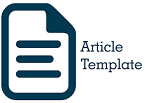IMAGERY ANALYSIS ON EMILY DICKINSONS POETRY
Abstract
Keywords
Full Text:
PDFReferences
Abrams, M.H., & Harpham, G.G. (2009). A Glossary of Literary Terms, (9th ed.). Boston: Wadsworth Cengage Learning.
Baldick, C. (2001). Oxford Concise Dictionary of Literary Terms. New York, NY: Oxford University Press.
Brown, H. D. (2007). Principles of Language Learning and Teaching. USA: Longman.
Cuddon, J.A. (2013). A Dictionary of Literary Terms and Literary Theory. USA: Willey-Blackwell Publisher.
Damanhuri, M. (2011). Imagery and Figurative Language Analysis on Robert frost’s Poem: To Earthward and Wind and Window Flower: Undergraduate Thesis. Jakarta: State Islamic University of Hidayahtullah.
Donald, Ary. (2010). Introduction to Research in Education. New York, NY: Nelson Education, Ltd.Eagleton, T. (1990). An Introduction to Literature. New York, NY: Scott.
Fromkin, V., Rodman, R., & Hyams, N. (2003). An Introduction to Language, (7th ed.). New York, NY: Wadsworth, Thomson and The Thomson Corporation.
Hornby, A.S. (2010). Oxford Advanced Learner’s Dictionary: International Student’s Edition, (8th ed.). New York, NY: Oxford University Press.
Kristeva J. (1984).Revolution in Poetic Language. New York, NY: Columbia University Press.
Mikics, D. (2007). A New Handbook of Literary Terms. London: Yale University Press.
Quinn, E. (2006). A Dictionary of Literary & Thematics Terms. New York, NY: Facts On File, Inc.
Richards, C. J., Schmidt, R., Kendricks, H. & Kim, Y. (2002). Longman Dictionary of Language Teaching and Applied Linguistics, (3th ed.). London, UK: Longman Group Limited.
Robert, E. V,& Jacob. H. (1982). Fiction: An Introduction to Reading and Writing. New Jersey, NJ: Prentice-Hall, Inc.
Tavakoli, H. (2012). A Dictionary of Research Methodology and Statistics in Applied Linguistics, (1st ed.). Tehran: Rahnama Press.
Tejvan. (2006). Biography of Emily Dickinson. Retrieved fromhttp://www.biographyonline.net
Wellek, R., & Warren, A. (1977). Theory of Literature (3rded.). New York, NY: Pinguin Books, Ltd.
DOI: https://doi.org/10.32502/ecj.v1i1.649
Refbacks
- There are currently no refbacks.
Copyright (c) 2017 English Community Journal
The Departement of English Education, Faculty of Teacher Training and Education, Universitas Muhammadiyah Palembang
Jl. Jenderal A. Yani 13 Ulu, Seberang Ulu II, Palembang (30263), Indonesia.
Indexed by :
English Community Journal has been listed in :

English Community Journal by http://jurnal.um-palembang.ac.id/index.php/englishcommunity is licensed under a Creative Commons Attribution-ShareAlike 4.0 International License.







